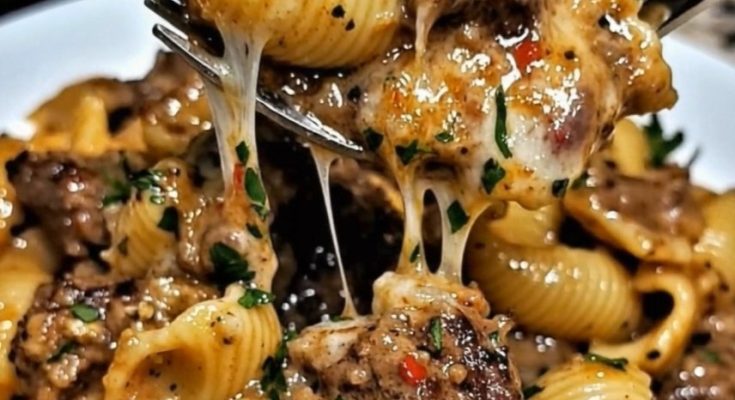This Creamy Paprika Steak Shells dish is where comfort meets indulgence — tender seared steak mingling with buttery pasta shells in a smoky, velvety sauce that feels both rustic and refined.
The combination of paprika, garlic, and Parmesan weaves layers of warmth and richness into every bite, while the cream ties it all together with a silky finish.
Wach forkful delivers the satisfying chew of steak, the softness of pasta, and the luxurious depth of a sauce that clings to every curve of the shells. It’s the perfect marriage of steakhouse elegance and home-style comfort — a meal that feels special yet deeply familiar.
Why People Will Love Creamy Paprika Steak Shells:
Rich and comforting: Every bite combines tender steak, buttery pasta shells, and a velvety cream sauce — the kind of warmth that feels like an embrace at the end of a long day.
Steakhouse flavor at home: With just one pan and simple ingredients, you can recreate the richness of a restaurant-quality steak dish in your own kitchen.
Perfect flavor balance: Smoked paprika adds gentle warmth and depth, while Parmesan cheese and garlic bring savory harmony that complements the seared steak beautifully.
Textural perfection: The chewy bite of steak, the soft pasta shells, and the silky cream sauce come together in an irresistible contrast of comfort and indulgence.
Quick yet luxurious: It feels like a special-occasion meal, yet it comes together easily — making it perfect for both weeknights and elegant dinners.
Visually stunning: The sauce’s golden hue from smoked paprika and the glistening seared steak pieces make this dish as beautiful as it is satisfying.
Universal appeal: Creamy, savory, and deeply flavorful — it’s a dish that speaks to everyone who loves hearty comfort food with a touch of sophistication.
Key Ingredients
Steak (Sirloin or Ribeye): The star of the dish — tender, juicy, and flavorful. When seared, it develops a golden crust that releases rich, savory juices into the sauce, giving the entire dish its steakhouse depth.
Shell Pasta: The perfect choice for this creamy sauce. Its curved shape cradles the paprika-spiced cream, ensuring every bite is filled with flavor and texture.
Smoked Paprika: The soul of the dish. It adds warmth, depth, and a whisper of smokiness that transforms the creamy sauce into something bold and memorable.
Garlic and Butter: The aromatic backbone — garlic infuses the butter with a gentle fragrance that enhances the richness of the steak and sauce.
Heavy Cream and Beef Broth: A luxurious blend of silkiness and savoriness. The cream softens the paprika’s edge, while the broth deepens the meaty undertone that ties the pasta and steak together.
Parmesan Cheese: Adds a nutty saltiness and velvety texture to the sauce, giving it that irresistible umami depth that lingers on the palate.
Fresh Parsley: A bright finishing touch — its herbal freshness cuts through the richness, balancing every element beautifully.
Expert Tips:
Choose the right cut of steak: Use well-marbled cuts like sirloin, ribeye, or New York strip. The natural fat in these cuts melts during searing, enriching the sauce with savory depth. Lean cuts will work, but they won’t deliver the same tenderness or flavor intensity.
Sear with intention: Pat the steak dry before seasoning — moisture prevents browning. Heat the skillet until it’s just shy of smoking, then sear the steak undisturbed for 2–3 minutes per side. That caramelized crust builds the base for a deeply flavorful sauce.
Season generously, but balance wisely: Salt enhances the meat’s richness, while smoked paprika adds warmth and color. Use freshly cracked pepper for brightness, and adjust seasoning after adding the cream — flavors mellow as the sauce thickens.
Control the heat when adding cream: Once the steak is set aside, lower the heat before stirring in the cream and broth. Cream thickens best over gentle heat — boiling can cause separation or a greasy texture. Slow simmering keeps it silky and cohesive.
Layer flavor through the fond: After searing, never wipe the skillet. The browned bits (fond) left behind hold concentrated flavor. Deglaze them with beef broth or a splash of white wine before adding cream — it transforms the sauce from good to extraordinary.
Use freshly grated Parmesan: Pre-shredded cheese often contains anti-caking agents that prevent melting smoothly. Freshly grated Parmesan melts evenly into the sauce, giving it that luxurious, velvety texture.
Toss pasta directly in the sauce: Don’t just pour sauce over the pasta — coat the shells in the skillet so they absorb flavor and thicken slightly from the residual starch. This creates that cohesive, restaurant-quality creaminess.
Finish with balance: Right before serving, taste the sauce — it should feel rich but not heavy. A sprinkle of parsley or a squeeze of lemon juice lifts the flavors, cutting through the richness and making every bite bright and complete.
Creamy Paprika Steak Shells
Ingredients:
Shell pasta – 12 oz (medium-sized, cooked al dente)
Steak – 1 lb sirloin or ribeye, cut into bite-sized cubes
Salt & freshly ground black pepper – to taste
Olive oil – 1 tablespoon
Butter – 1 tablespoon
Garlic – 3 cloves, finely minced
Smoked paprika – 1 ½ teaspoons
Heavy cream – 1 cup
Beef broth – ½ cup
Parmesan cheese – ½ cup, freshly grated
Fresh parsley – chopped, for garnish
Instructions:
Cook the pasta: Boil the shell pasta in a large pot of salted water according to package directions. Drain well and set aside.
Season the steak: Toss the steak pieces with salt, black pepper, and smoked paprika until evenly coated.
Sear the steak: Heat olive oil in a large skillet over medium-high heat. Add the steak and sear for 2–3 minutes per side until browned. Remove from the skillet and set aside.
Sauté the garlic: Lower the heat to medium. Add butter to the same skillet, then stir in the minced garlic. Cook for about 1 minute, just until fragrant.
Build the sauce: Pour in the heavy cream and beef broth, stirring to combine. Let the mixture simmer for 3–4 minutes until slightly thickened.
Add cheese: Stir in the grated Parmesan until fully melted and the sauce becomes smooth and creamy.
Combine everything: Return the cooked pasta and seared steak to the skillet. Toss well so the shells are coated evenly in the sauce.
Finish and serve: Garnish with fresh parsley and serve immediately while hot.
Important Notes When Making Creamy Paprika Steak Shells
Quality of steak defines the dish: The better the steak, the richer the final flavor. Use fresh, well-marbled cuts — sirloin for tenderness or ribeye for deeper flavor. Trim only excess fat; a little fat renders into the sauce and amplifies its richness.
Timing is everything: Sear the steak quickly over high heat to lock in juices, then remove it before it overcooks. It will continue to cook slightly when returned to the sauce, so stop just before your preferred doneness.
Balance the paprika: Smoked paprika is powerful — it should add warmth, not dominate. Start with the recipe amount and adjust at the end; its flavor intensifies as the sauce simmers.
Control the cream: Once you add heavy cream, reduce the heat and avoid boiling. High heat can break the sauce, causing it to separate or lose its velvety texture. Gentle simmering is the secret to a smooth, glossy finish.
Taste before finishing: Parmesan adds saltiness, so always taste after adding the cheese before seasoning further. The goal is a balanced sauce where creaminess, spice, and savory depth complement each other perfectly.
Pasta absorbs flavor while it rests: Let the finished pasta sit for 2–3 minutes off the heat before serving. The shells will soak up the sauce slightly, creating that cohesive, restaurant-style creaminess.
Use freshly grated cheese: It melts smoothly and binds naturally with the cream and broth. Pre-grated cheese can clump or create a grainy texture in the sauce.
Don’t overcrowd the pan when searing: Overcrowding traps steam and prevents proper browning. Work in batches if needed — color equals flavor, and that caramelized crust is what makes the sauce exceptional.
Serve immediately: This dish is best enjoyed hot, when the sauce is at its creamiest and the steak is tender. If you must reheat, do so gently over low heat with a splash of cream or broth to loosen the sauce without curdling it.
A touch of freshness completes it: Right before serving, sprinkle chopped parsley or a hint of lemon zest — the brightness cuts through the richness and adds elegance to every bite.
How to Enjoy Creamy Paprika Steak Shells After Cooking
Let the flavors settle: Once removed from the heat, allow the dish to rest for 3–5 minutes. This short pause gives the sauce time to thicken slightly and cling beautifully to the pasta shells, while the steak relaxes and becomes even more tender.
Serve it at the right warmth: This dish shines when served warm — not piping hot. At this temperature, the smoked paprika and garlic release their full aroma, and the cream maintains its smooth, luxurious texture without feeling heavy.
Plate it with care: Spoon the shells and steak into shallow bowls, allowing the sauce to pool just slightly at the bottom. Finish with a light dusting of Parmesan and a sprinkle of fresh parsley for color and brightness. The presentation should mirror the dish itself — simple yet deeply inviting.
Pair thoughtfully:
- For a cozy meal: Serve with warm garlic bread or a slice of crusty baguette to catch every drop of the creamy sauce.
- For a balanced plate: Pair with a crisp green salad tossed in lemon vinaigrette — its acidity cuts through the richness perfectly.
- For an elegant dinner: A glass of red wine such as Cabernet Sauvignon or Malbec enhances the smoky depth of the paprika and complements the seared steak’s richness.
Savor the textures: Take your time — the al dente shells, the tender steak, and the velvety sauce come together in layers of comfort. Each bite should feel indulgent but balanced, with the paprika’s warmth deepening as you eat.
Enjoy the aftertaste: The smoked paprika leaves a subtle lingering spice on the palate, followed by the nutty saltiness of Parmesan. Let it unfold slowly — it’s part of what makes this dish feel both rustic and refined.
Relish the next-day richness: Like many cream-based pastas, this dish grows deeper in flavor after resting overnight. Reheat gently over low heat with a splash of cream or broth, and it becomes even silkier — a perfect encore for the next day.
Make it a moment: Serve it by candlelight, share it over laughter, or enjoy it quietly at the end of a long day. Creamy Paprika Steak Shells isn’t just dinner — it’s a dish that asks you to slow down, taste deeply, and feel the comfort it brings.
Nutrition Information:
For your Creamy Paprika Steak Shells (per serving, based on 4 servings total):
Calories: 540 kcal | Total Fat: 32.6 g | Saturated Fat: 13.1 g | Monounsaturated Fat: 13.4 g | Polyunsaturated Fat: 1.7 g | Cholesterol: 135 mg | Sodium: 520–680 mg (depending on added salt and cheese) | Total Carbohydrates: 28.9 g | Dietary Fiber: 2.1 g | Sugars: 2.8 g | Protein: 36.4 g
Frequently Asked Questions
Can I use a different type of pasta instead of shells?
Yes. While shell pasta beautifully holds the creamy sauce, you can substitute with penne, rigatoni, or farfalle. The key is to choose a shape with curves or ridges that can capture the rich, paprika-infused sauce.
What kind of steak works best for this dish?
Sirloin or ribeye are ideal — they offer tenderness and a deep, meaty flavor that stands up to the cream sauce. If you prefer leaner cuts, flank or strip steak will work too, but be careful not to overcook them or they’ll lose their tenderness.
Can I make this dish ahead of time?
You can prepare the sauce and steak in advance, but for the best texture, cook the pasta fresh before serving. If reheating, warm the sauce gently over low heat and add a splash of cream or broth to restore its silky consistency — avoid boiling to prevent separation.
How can I make the sauce thicker or creamier?
Let the sauce simmer a few minutes longer to reduce naturally, or stir in a tablespoon of freshly grated Parmesan at a time until it reaches your desired thickness. Avoid cornstarch or flour unless absolutely necessary — the natural reduction creates a more luxurious mouthfeel.
What sides or garnishes go best with this dish?
Serve it with a crisp green salad dressed in lemon vinaigrette, roasted vegetables, or warm garlic bread. For an elegant finish, sprinkle a touch of smoked paprika, extra Parmesan, or a few parsley leaves on top before serving.
How do I get the perfect sear on the steak without overcooking it?
Pat the steak pieces completely dry before seasoning — moisture prevents browning. Use a heavy skillet (preferably cast iron) and heat it until just smoking. Add the steak in batches to avoid crowding, and sear undisturbed for 2–3 minutes per side. Once caramelized, remove immediately; the residual heat will finish cooking them gently in the sauce later.
Why does my cream sauce sometimes separate or look oily?
This usually happens when the sauce is overheated. After adding the heavy cream, keep the heat on low to medium-low and avoid boiling. Stir constantly and add the Parmesan gradually — high heat or rapid boiling can cause the fats in the cream to split, ruining the silky consistency.
Can I use milk instead of heavy cream?
You can, but the sauce will be lighter and less rich. To maintain creaminess, use whole milk mixed with a teaspoon of cornstarch or substitute half-and-half. If using milk, simmer very gently and avoid adding cold ingredients directly to the hot sauce to prevent curdling.
How can I enhance the smoky paprika flavor without overpowering the dish?
Start with 1 teaspoon of smoked paprika, then build up gradually after tasting. For deeper smokiness, use a mix of smoked and sweet paprika or add a tiny pinch of chipotle powder. Balance the warmth with enough cream and Parmesan — they mellow the spice and add harmony.
What’s the best way to reheat leftovers without losing the creamy texture?
Reheat gently over low heat in a skillet or saucepan. Add a splash of milk, cream, or broth to loosen the sauce, stirring as it warms. Avoid microwaving on high — the heat can separate the sauce and toughen the steak. Slow reheating keeps everything silky and tender.



